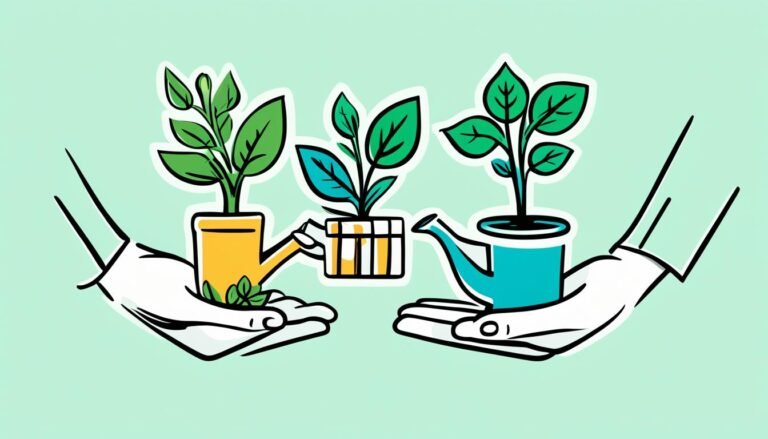Sales Funnel: Identifying and Nurturing Leads
In today’s fast-paced marketing world, the sales funnel is key for businesses. It helps them find, connect with, and turn potential customers into real ones. But what if the real strength of the sales funnel isn’t just in getting leads? What if it’s in helping them grow throughout their journey?
Are you making the most of your sales funnel by caring for your leads?
Key Takeaways
- The sales funnel is a model that describes the stages a potential customer goes through before making a purchase.
- Lead nurturing is the process of engaging and educating potential customers throughout their buying journey.
- Effective lead nurturing strategies can help businesses identify and nurture leads more effectively, ultimately driving more sales and revenue.
- Research suggests that businesses excelling at nurturing leads can generate 50% more sales at a 33% lower cost.
- Personalized and segmented lead nurturing campaigns can significantly improve conversion rates and customer loyalty.
Understanding Lead Nurturing and Its Importance
Lead nurturing is about engaging and teaching potential customers as they move through their buying journey. It means sending them valuable content and building a relationship. This helps guide them through the sales process. Forrester’s research shows that top companies at lead nurturing can get 50% more sales at a lower cost.
What is Lead Nurturing?
Lead nurturing tackles issues like long sales cycles, inactive leads, and high costs to get new customers. It boosts conversion rates, customer loyalty, and referrals. This leads to more revenue for businesses.
Benefits of Lead Nurturing for Your Business
- Increased conversion rates: Nurtured leads make purchases that are 47% larger than non-nurtured leads.
- Improved customer loyalty: Nurturing leads often leads to better customer retention, fostering trust and loyalty.
- More referrals: Nurturing leads can increase the likelihood of repeat purchases and referrals.
- Higher marketing ROI: Small and medium-sized businesses can maximize their marketing ROI by engaging with leads through a structured lead nurturing strategy.
- Reduced sales cycle length: Lead nurturing can result in a reduction in the sales cycle length, leading to a more efficient sales process.
Using strong lead nurturing strategies helps businesses overcome challenges. It boosts lead generation, lead management, and marketing automation. This leads to better success in content marketing and email marketing.
“Nurtured leads make purchases that are 47% larger than non-nurtured leads.”
The Sales Funnel: Stages and Lead Nurturing Strategies
Getting leads to become loyal customers is key. The sales funnel has four stages: awareness, interest, consideration, and decision. At each stage, special tactics help move prospects towards buying.
Top of the Funnel (TOFU) Nurturing Tactics
At the top of the funnel (TOFU), we grab attention and share valuable info. This helps solve the lead’s problems. Good TOFU tactics are:
- Being active on social media to get noticed and share knowledge
- Sharing free stuff like blog posts, ebooks, and webinars to help leads
- Sending automated emails with content that matters to leads
Middle of the Funnel (MOFU) Nurturing Tactics
MOFU is where leads check out different options and decide what they want. Here, strategies should be:
- Showing off your product with demos
- Offering free trials so leads can see your product’s benefits
- Sharing stories of how your product helped others
Bottom of the Funnel (BOFU) Nurturing Tactics
At the bottom of the funnel (BOFU), leads are almost ready to buy. Here, focus on:
- Following up to clear any doubts or worries
- Keeping top-notch service to build trust and loyalty
- Looking into upselling or cross-selling to grow the customer bond
Matching your lead nurturing with the sales funnel stages helps move prospects to buying. It also builds strong customer relationships.
Personalization and Segmentation for Effective Lead Nurturing
In today’s marketing world, personalization and segmentation are key for nurturing leads. By gathering data on leads’ details, interests, and actions, companies can make content that speaks to each person.
Lead nurturing can generate 50% more sales-ready leads at a 33% lower cost (Marketo). This is where personalization and segmentation shine. By sorting leads by their sales stage and buying intent, companies can send the right message at the right time. This leads to more sales.
Good email marketing uses segmentation (78%), personalization (72%), and automated emails (71%) (HubSpot). Half of consumers buy from marketing emails every month (Salecycle). Abandoned cart emails also have three times higher conversion rates than other automated emails (Email Tool Tester).
Personalization and segmentation boost lead-nurturing email campaigns’ performance and conversion rates. They also improve customer engagement and keep customers coming back. When used with lead scoring, this approach helps focus on leads most likely to convert, making sales more efficient.
“Nurtured leads make 47% larger purchases than non-nurtured leads, leading to a 20% increase in sales opportunities on average.”
By using personalization and segmentation, companies can make content and offers that hit the mark with their audience. This leads to a big jump in revenue and customer loyalty.
Building Relationships and Providing Value
Lead nurturing is more than just guiding leads through the sales funnel. It’s about building strong relationships and offering real value. By sending personalized emails, engaging on social media, and following up on time, you keep your business in front of your leads. This shows you care about their success.
Consistent Communication and Value Delivery
Sharing valuable content and solutions that solve problems can build trust. This makes your business a trusted advisor. Trust leads to loyal customers, more repeat business, and good word-of-mouth. In fact, nurturing leads can increase sales by 50% and cut down on customer acquisition costs.
Fostering Relationships and Trust
Lead nurturing strengthens relationships, which can lead to more deals. It also improves customer service by helping at every sales stage. Plus, it opens doors for upselling and cross-selling, which can boost sales and increase customer value over time. A strong nurturing strategy is key for long-term business success.
“Lead nurturing allows for engaging prospects over time, building trust and credibility with the aim of increasing the likelihood of conversion.”
Good lead nurturing means knowing your audience, segmenting leads, and making engaging content. It also means using automation, personalization, and checking results to get better over time.
Sales Funnel: Identifying and Nurturing Leads
The sales funnel is key for businesses to find and care for leads well. It helps companies know the buyer’s journey stages – Awareness, Consideration, and Decision. This way, they can use lead nurturing strategies to move prospects to loyal customers.
Good lead nurturing means sales and marketing teams work together. They use marketing automation and CRM tools to make the process smooth. This helps businesses know about potential customers’ details, making lead nurturing more personal.
Creating a clear customer journey map is vital for a focused content plan. This plan can include many types of content. Automated emails and retargeting ads help keep the brand in front of potential customers at different stages.
Personal touches like birthday greetings or special offers build strong customer bonds. It’s key to track how well different marketing works. This helps improve marketing automation and sales funnel results.
“According to research firm SiriusDecisions, sales reps follow up on only 20% of leads, out of which 70% are not qualified. However, 80% of leads that do not qualify immediately are likely to make a purchase within the next 24 months.”
By always checking and tweaking the lead nurturing process, companies can get better at converting leads. This leads to more customer loyalty and better sales performance.
Tracking, Measuring, and Optimizing Lead Nurturing
Effective lead nurturing is more than just a strategy. It also means closely watching and improving the process. By setting key performance indicators (KPIs) and using analytics, businesses can learn a lot about their lead nurturing. They can see what works and what needs to get better.
Key Performance Indicators (KPIs) and Analytics
Important KPIs for Lead Nurturing include lead conversion rates, customer acquisition costs, and customer lifetime value. These numbers show how well the strategy is doing and the return on investment. With marketing automation and CRM tools, businesses can track lead behavior, engagement, and conversion points. This helps them make smart choices about their Lead Nurturing.
Optimizing Conversion Points
After setting up KPIs and analytics, it’s time to test and improve the Lead Nurturing strategy. This might mean testing different content, offers, or ways of communicating to see what works best with the audience. Conversion Optimization and always trying new things are crucial for better Lead Nurturing results.
“On average, having lead scoring in place can result in a 30% increase in deal close rates.” – DemandGen Report
By using KPIs, Analytics, and Conversion Optimization, businesses can make their Lead Nurturing, Marketing Automation, and CRM strategies better. This helps them engage and convert leads into loyal customers more effectively.
Conclusion
Effective lead nurturing is key to a successful sales funnel. It helps businesses guide potential customers through their buying journey. This builds trust and loyalty, leading to more sales and revenue.
Personalization, consistent communication, and valuable content are crucial. They help build strong relationships with leads. Tracking and improving the lead nurturing process is also vital for better results. A thorough lead nurturing approach can unlock a business’s sales funnel potential, leading to growth and success.
Using marketing automation tools can boost lead engagement. Segmenting leads for personalized messages is another effective strategy. These methods help businesses improve their lead generation and customer retention. Staying focused on the customer leads to long-term CRM success.
Source Links
- Nurturing Leads Through Funnels – Web Marketer
- How to Nurture B2B Sales Leads
- Lead Nurturing: Breaking Down Your Sales Funnel & Building an Effective Lead Nurturing Strategy (with 7 Tips)
- Lead Nurturing: Definition, Strategy, and How To Do it Successfully
- What is Lead Nurturing? Examples, Strategies, & Tips
- The ultimate lead nurturing guide for 2024 (strategy & statistics)
- Writing a Lead Nurturing Email? See My Essential 7 Tips to Get It Right
- The benefits of personalized lead nurturing campaigns
- Blog | Debutify
- Nurturing marketing throughout your funnel
- Lead Nurturing: The Ultimate Guide to Building Relationships with Your Leads and Moving Them Down the Sales Funnel – FasterCapital
- Lead Nurturing from Introduction to Sale | Mailchimp
- What is Lead Nurturing?
- What are the most effective ways to measure lead nurturing success?
- Lead Scoring or Lead Nurturing: Making the Right Choice for Your Sales Funnel
- Nurturing Leads into Customers: Best Practices for Sales Funnel Management
- How to use email marketing to nurture leads through the sales funnel
- Lead Generation vs Lead Nurturing: What’s the Difference?







